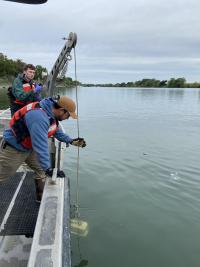This project focuses on nitrogen and carbon cycling within the Sacramento-San Joaquin Delta (Delta), both before and after 2021 upgrades to the Sacramento Regional Wastewater Treatment Plant (SRWTP). The team quantified whole-system rates of ecosystem metabolism and nitrogen cycling, pairing them with field measurements of benthic nitrate and oxygen fluxes to separate benthic from pelagic processes.

The SRWTP represents one of the largest point sources of nitrogen to the Delta, and the upgrades were projected to cut nitrogen outputs from the plant by approximately 65 percent. This project helps to assess the efficacy of this major management action. The results will also help improve biogeochemical models for the Delta.
Research Conclusions
Unlike previous research that primarily focused on the role of phytoplankton on ecosystem metabolism and carbon cycling, the research team concluded that ecosystem metabolism in the Delta is primarily driven by benthic aquatic plants, or macrophytes, many of which are invasive. Additional analysis suggests that previously high nitrification rates in the Sacramento River have been substantially diminished following upgrades to the Sacramento River Wastewater Treatment Plant, which included adding nitrification of effluent prior to discharge to the Sacramento River. These changes to the nitrogen cycle likely impact ecosystem metabolism in the river, and the team is currently in the process of better elucidating these links.
Attachments
 Martin Volaric
Martin Volaric